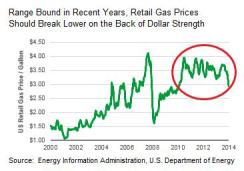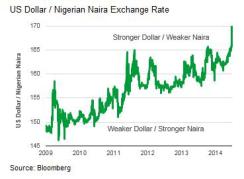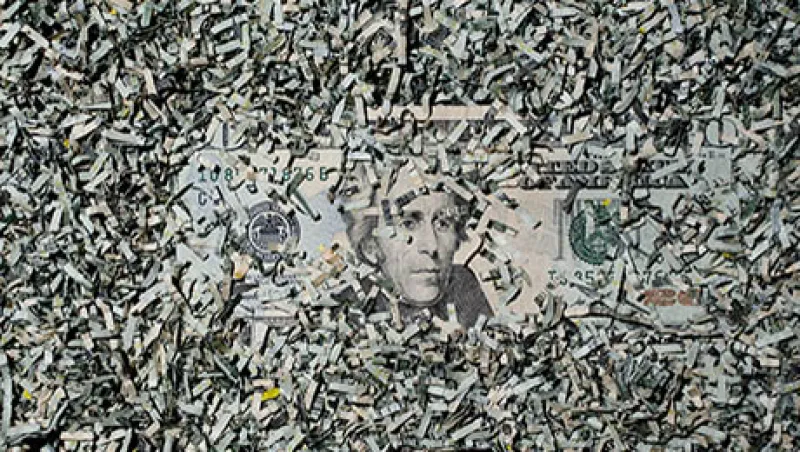In 2010 policymakers roundly criticized Brazilian Finance Minister Guido Mantega for engaging in extreme rhetoric when he brought up the possibility of the Federal Reserve’s quantitative easing causing a currency war, making for a cheaper dollar and cheaper exports. Today some Fed officials are of course concerned with the opposite situation: U.S. dollar gains that could put the U.S. recovery at risk. We at BlackRock think this is highly unlikely.
First, it must be understood that although the U.S. export sector receives a good deal of attention, it is not an overly large component of total U.S. gross domestic product — 13 percent, according to Bank of America Merrill Lynch research. In contrast, the same body of research shows that in the euro zone exports of goods and services represent nearly 46 percent of the region’s GDP, and in commodity-rich Canada exports account for 30 percent of GDP. Relative to many comparable economies, the U.S. economy is a relatively closed system, with domestic consumption far and away the most important factor in economic growth. Additionally, although the dollar has significantly strengthened recently, it has done so in the context of secular dollar decline versus global currency baskets. In a sense, we are only retracing our steps to levels seen in the recent past.
Second, dollar strength may help stave off the threat of imported deflation from Europe. By helping to drive down the euro exchange rate as the European Central Bank takes a page from the Bank of Japan’s recent playbook, a strong dollar can make the region more competitive. Moreover, many analyses that express worries about dollar strength fail to fully account for the corresponding reduction in the cost of imports — particularly commodities — which clearly benefit a consumption-led economy.
Dollar strength also acts as a stabilizing force for commodities priced in dollars and reduces the volatility of energy inputs, which can persuade businesses to consider increasing their long-term capital spending. At the consumer level, the relationship is even more straightforward. Reduced energy costs work effectively as a tax cut, raising disposable income and facilitating further spending.

That dynamic creates what might be termed positive disinflation. This economic trend strongly benefits lower-income households, which have a tendency to spend money saved at the pump and via lower utility bills. Indeed, according to data from the U.S. Bureau of Labor Statistics, households in the bottom income quintile devote more than 15 percent of their total expenditures on utilities and fuel, whereas the top quintile spends less than 10 percent. And although retail gas prices have been fairly range bound in recent years, they have recently broken out lower and we think it’s likely that they will continue to sink, (see chart 1), with positive implications for consumer spending.
Without question, there is more to positive disinflation than dollar strength. The revolution in North American energy production and technological innovations also play very significant roles, as does the slowing in China’s economic growth rate and the corresponding decline in commodities prices. The importance of dollar strength should not be discounted, however. As the economies of the U.S. and U.K. solidly recover and approach policy normalization while the euro zone and Japan struggle economically and continue to ease, we have witnessed a separation in real rates, a strong factor in currency movements. Some have argued that lower oil prices will hurt U.S. energy sector capital expenditures — which we wouldn’t disagree with — but we would suggest that this deleterious point in commodity prices is considerably below current levels and that these negative influences will be far outweighed by positives to consumer spending.
There are, however, other factors at play, as illustrated by the fact that the recent dollar rally has coincided with a decline in longer-end Treasury rates. Indeed, this dynamic suggests to us that there is a shortage of both U.S. dollars and Treasury paper relative to demand. The shortage in U.S. Treasuries largely stems from the Fed’s balance sheet, whereby there are simply fewer bonds in the market after years of Fed purchases. Beyond that fact, foreign central banks and reserve managers also have a tremendous need for Treasury securities, which form the world’s primary source of collateral. Fascinatingly, a dollar shortage may be explained in part by a drop in petrodollar supply driven by the North American shale oil revolution. In fact, a stock of withheld petrodollars may be having a scarcity effect on the dollar similar to that of the increased Fed balance sheet on Treasury securities.
To illustrate this point, we should first recognize the fact that the global supply of dollars via the U.S. trade balance was roughly 30 percent lower in the five years from 2009 to 2013 than in the previous five-year period. Further, dollar scarcity is not a phenomenon that is evenly shared across trade partners but rather can be region — or even country — specific. Since 2009, for instance, U.S. oil imports from Nigeria have declined by about 250,000 barrels per day to near negligible levels; at the same time, the Nigerian naira has dropped by roughly 13 percent versus the dollar (see chart 2). As the supply of dollars that once flowed into Nigeria has declined, the impact on the naira is clear.

The upshot of these dynamics for investors is that there is likely to be a strong structural bid for the dollar for some time, as well as a cap on Treasury yields. When looking at a combination of factors — the U.S. economy’s relative strength versus much of the rest of the world, its relatively higher levels of real rates than comparable developed markets, the Fed’s proximity to rate normalization and the dollar-scarcity issue described above — it becomes clear to us that the dollar should continue to strengthen versus most major currencies. Furthermore, these currency gains should not be perceived by policymakers as a risk to recovery, because in many respects they instead represent and reinforce U.S. economic strength.
Rick Rieder, managing director, is chief investment officer of fundamental fixed income and co-head of Americas fixed income for BlackRock in New York.
Get more on foreign exchange.






